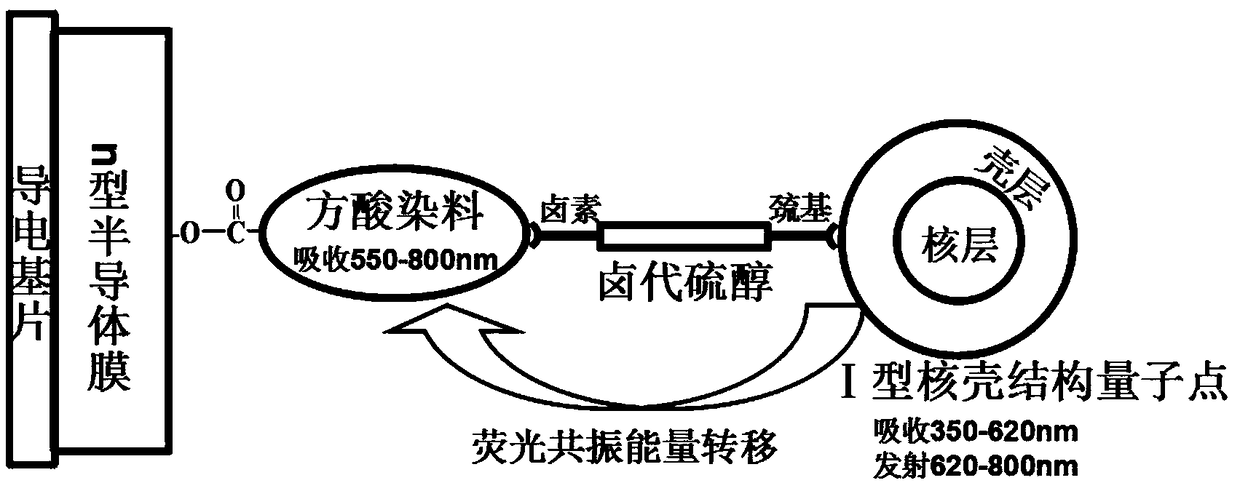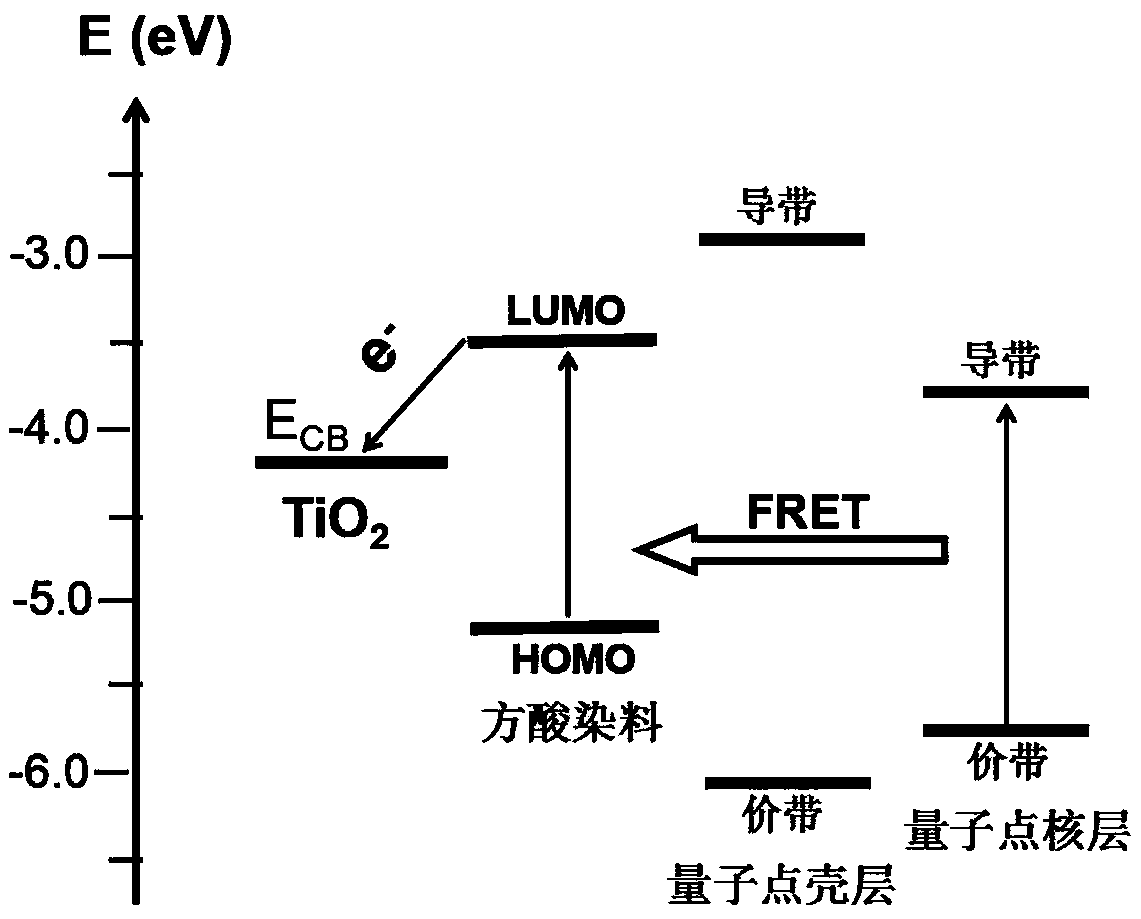Fluorescence resonance energy transfer photoanode and preparation method thereof
A fluorescence resonance energy, photoanode technology, applied in the field of photoanode, can solve the problems of complex reaction, difficult spacing control, limited FRET energy transfer efficiency, etc., to achieve the effect of wide spectral response range and high light absorption efficiency
- Summary
- Abstract
- Description
- Claims
- Application Information
AI Technical Summary
Problems solved by technology
Method used
Image
Examples
preparation example Construction
[0031] A method for preparing a fluorescent resonance energy transfer photoanode, comprising sensitizing an n-type semiconductor film deposited on a conductive substrate in an alcohol solution of squarylium dye, and refluxing the halogenated film in a toluene solution of a halogenated thioacetate. After hydrolysis, a semiconductor photoanode connected with functional bridge chain molecules is obtained; the type I core-shell structure quantum dot containing ZnS shell is bonded with the semiconductor photoanode connected with functional bridge chain molecules.
[0032] The n-type semiconductor film is soaked in the alcohol solution of squarylium dye, the carboxyl group of the squarylium dye is bonded to the n-type semiconductor film, and the squarylium dye is adsorbed on the n-type semiconductor film to obtain the semiconductor photoanode sensitized by the squarylium dye.
[0033]The alcohol solution of the squaraine dye is an alcohol solution containing SQ1, SQ2, SQ3, SQ4 or SQ5...
Embodiment 1
[0052] a. Heat the porous n-type TiO2 film deposited on a transparent conductive substrate at 80°C for 2h, and place it in SQ1 with a concentration of 3×10 -4 mol / L ethanol solution for 12 hours. Take it out, rinse it with absolute ethanol, and dry it to get the SQ1-sensitized semiconductor photoanode.
[0053] b. Dissolving ethyl 2-iodothioacetate in toluene to prepare a toluene solution with a concentration of ethyl 2-iodothioacetate of 0.02 mol / L. Immerse the semiconductor photoanode sensitized by SQ1, under the protection of nitrogen, and react under constant temperature reflux at 20°C for 8h. Take it out, wash it with toluene, and dry it to get a precursor semiconductor photoanode connected with functional bridge chain molecules.
[0054] c. Immerse the precursor semiconductor photoanode connected with functional bridge chain molecules in ethanol, adjust the pH to 8 with KOH, and react at room temperature for 0.5 h. Take it out, rinse it with ethanol, and dry it to get...
Embodiment 2
[0058] a. Heat the porous n-type TiO2 film deposited on the transparent conductive substrate at 100°C for 0.5h, and place it in SQ1 with a concentration of 6×10 -4 mol / L ethanol solution for 24 hours. Take it out, rinse it with absolute ethanol, and dry it to get the SQ1-sensitized semiconductor photoanode.
[0059] b. Dissolving 3-iodopropyl thioacetate in toluene to prepare 3-iodopropyl thioacetate concentration in toluene solution of 0.02mol / L. Immerse the semiconductor photoanode sensitized by SQ1, under the protection of nitrogen, and react under constant temperature reflux at 20°C for 8h. Take it out, wash it with toluene, and blow it dry to obtain a semiconductor photoanode connected with a functional bridge chain molecular precursor.
[0060] c. Immerse the semiconductor photoanode connected with the functional bridge molecular precursor in ethanol, adjust the pH to 8 with NaOH, and react at room temperature for 0.5 h. Take it out, rinse it with ethanol, and dry it ...
PUM
 Login to View More
Login to View More Abstract
Description
Claims
Application Information
 Login to View More
Login to View More - R&D
- Intellectual Property
- Life Sciences
- Materials
- Tech Scout
- Unparalleled Data Quality
- Higher Quality Content
- 60% Fewer Hallucinations
Browse by: Latest US Patents, China's latest patents, Technical Efficacy Thesaurus, Application Domain, Technology Topic, Popular Technical Reports.
© 2025 PatSnap. All rights reserved.Legal|Privacy policy|Modern Slavery Act Transparency Statement|Sitemap|About US| Contact US: help@patsnap.com



